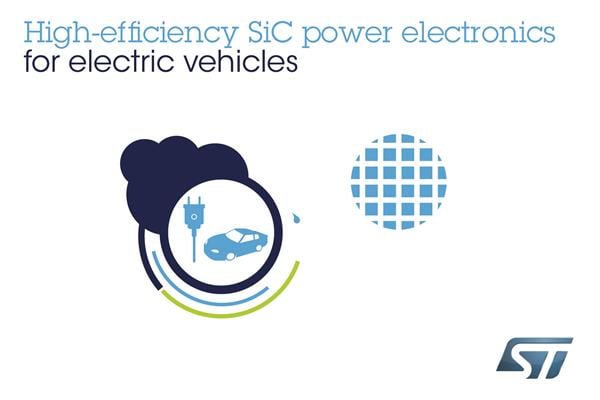Silicon carbide (SiC) power devices have been singled out by automakers for high-speed charging in automotive applications.
In addition, ST will also supply Renault-Nissan-Mitsubishi with standard silicon devices, as well as with associated electronic components. Volume production of SiC-based OBCs is expected to start by 2021.

Image from STMicroelectronics
On-Board Charging
Electric Vehicles (EVs) require an OBC in order to interface with the array of electric vehicle charging stations now developing worldwide. The all-important recharge time, the time it takes for an electrical to “fill up,” depends largely on the OBC’s power rating. This down-time is still far longer than it takes to fill a tank of gas. This is arguably the most critical barrier now remaining to the widespread public acceptance of EVs.Renault’s Zoe, a five-door supermini, presently sports a 22kW OBC which can fully recharge its battery in about an hour. Through upgrading the OBC to exploit the ST’s SiC power semiconductors, the Alliance will be able to reduce the OBC’s size, weight, and cost while at the same time increasing the device’s energy efficiency.
Silicon Carbide’s Advantages
SiC is a technology that forms the basis of modern power switches (MOSFETs) and rectifiers (diodes). SiC is a wide bandgap (WBG) semiconductor material that works efficiently at higher frequencies and can withstand higher operating temperatures. At the same time, this allows for the fabrication of components featuring smaller form factors than those devices composed of traditional silicon-based materials.Silicon carbide as it's found in nature. Photo by Scott Horvath, USGS
SiC semiconductors give component engineers better control over device characteristics and more room for trade-offs. Important parameters include:
- Low MOSFET on-resistance (RDS(ON)): This is the resistance a semiconductor offers when it is in conduction mode. Charging currents in for EVs are extremely high. And, as power loss through a resistance is I2R, a low conduction resistance is vital for efficiency.
- Low diode forward voltage (VF): This serves to minimize its conduction losses and thereby increases efficiency.
- Factors including capacitance and gate charge: These affect efficiency. They also affect the “switching speed” at which the OBC can operate at.
High Expectations for SiC
Marco Cassis, ST's President of Sales, Marketing, Communications, and Strategy Development states that “ST has successfully developed manufacturing processes and established a portfolio of qualified, commercialized SiC products also in automotive-grade version. Building on our long cooperation, we are now working with Renault-Nissan-Mitsubishi to realize the many advantages SiC can bring to EVs."Additionally, as described by Philippe Schulz the VP of Design Electric and Hybrid Powertrain at Alliance, “The small size, light weight, and high-energy efficiency we can achieve using ST’s SiC technology in our OBC, combined with the increased battery efficiency, will enable us to accelerate the adoption of electric vehicles by reducing charging times and extend the range of our EVs.”
More on SiC
If you'd like to learn more about wide-bandgap semiconductors, check out my roundup where I compare and contrast some of the important characteristics of gallium arsenide (GaAs) to those of classical silicon.To learn about interesting and important developments in lithium-ion batteries, don’t miss my article covering new electrode advances, which touches on Enevate's initiative for silicon electrode batteries with Alliance Ventures.
Where else have you seen SiC used? Do you expect WBG semiconductors to become more relevant to your job over time or are you unimpressed by the trend? Share your thoughts in the comments below.

No comments:
Post a Comment